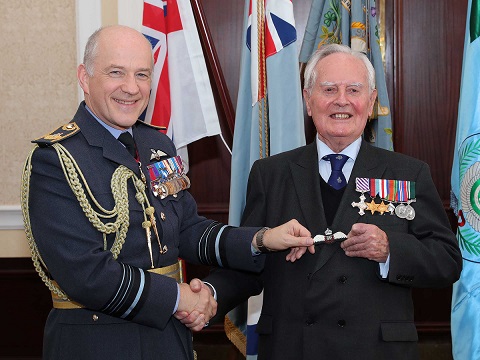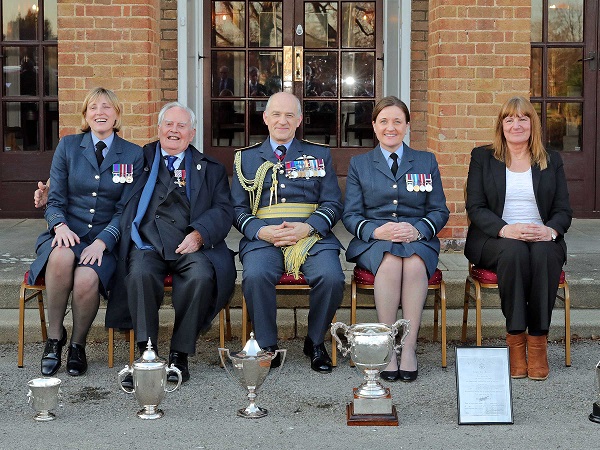Veteran World War Two pilot Flight Lieutenant Colin Bell DFC AE FRICS RAF (Retired) received his Royal Air Force pilot’s wings at a ceremony at Royal Air Force Linton-on-Ouse recently. Colin, who was born in 1921, was presented with his coveted Royal Air Force flying badge by Deputy Commander Operations, Air Marshal Stuart Atha CB DSO MA BSc RAF who also presented pilots’ wings to current Royal Air Force and Royal Navy pilots graduating on Number 270 Basic Fast Jet Training course.

Colin Bell joined Royal Air Force towards the end of 1940. His flying training was carried out in 1941 in the United States under the ‘Arnold Scheme’. Following the Japanese attack on Pearl Harbour in December 1941 and having successfully completed his flying training, Colin was commissioned into the Royal Air Force; however, he was retained in the United States by the American Army Air Corps as an advanced single-engine flying instructor responsible for training United States and British pilots flying Stearmans, Vultee and Harvard aircraft types.
Unlike his Royal Air Force pilot colleagues who returned to the United Kingdom immediately after their flying training, Colin was never formally presented with his Royal Air Force ‘wings’.
On his return to the United Kingdom in 1943 he converted to twin engine Mosquito Bombers and joined 608 Squadron (Pathfinder Group) based at Downham Market in Norfolk. During his operational tours he carried out 50 bombing raids over Germany, 13 of them over Berlin. He experienced much action and survived many close scrapes.
Colin said, “At the height of the bomber offensive a heavy bomber crew on a tour of 30 operations stood only a 25% chance of survival from being shot down, so perhaps it was better to be without any imagination at all in those dangerous days – even if you were flying a Mosquito”.
608 Squadron was part of the Light Night Strike Force which operated extensively over Germany, bombing industrial areas like Bremen, Magdeburg, Hamburg, Nuremburg , Dresden and of course Berlin. Berlin was the most heavily defended city in the Third Reich and was ringed by special anti-aircraft guns, able to fire to heights of 5-7 miles with great accuracy and controlled (together with searchlights) by radar. The objectives of a Mosquito bomber crew were to get in, bomb and get out. 608 Squadron’s Mosquito bombers were completely unarmed – no guns. Their very high speed was partly attributable to a complete lack of armaments as turrets or guns would add weight. With their 2 Spitfire engines it was this high speed that was their main defence against the German Night Fighters.
Mosquitos flew so high and fast that very few enemy fighters at the same altitude could catch them. The Germans tried to counter the Mosquitos by stacking Focke Wulfe 190s over targeted cities at 30,000 feet or more to give them a height and diving speed advantage. The Luftwaffe called them Wild Boar Squadrons. The Focke Wulfe 190s’ first attacks had to succeed. If they missed, it was generally too late to mount a second attack. Consequently, Mosquito crews had to try to spot the German aircraft before they themselves were spotted. It was reckoned that for every Mosquito over Berlin there was a German night fighter up there, waiting, hoping to get a crack at it.
Colin recalled the time he arrived at 608 Squadron, “By now I was a relatively experienced pilot, which helped, with my very experienced Canadian Navigator, Doug Redmond, some years older than myself, that also helped a lot. But neither Doug or I had any battle experience. Our first raid was on Hanover. When we arrived over the target it was shrouded in thick cloud. This didn’t stop the Germans sending up radar-controlled anti-aircraft fire, which was a bit scary for a couple of naive aircrew who had never seen or experienced anything like it before. We were looking for target indicators, which were supposed to have been dropped by fellow Pathfinder markers. We couldn’t see anything so we hung around, trying to make up our minds what to do. Eventually after losing height, we bombed on time and distance, dead reckoning, just as a solitary target indicator appeared through a gap in the cloud. The on-board camera whirled automatically, took a photograph and later on, back at base, we acquired a quite unjustifiable reputation as a press-on crew. It didn’t last for long! On our way back, we passed over Emden. We shouldn’t have done it, the only time my brilliant navigator failed me, although it was my fault as well as his. We were completely inexperienced and naive. Half a mile ahead we saw anti-aircraft shell bursts. Doug said to me “who are they firing at?” A couple of seconds later we knew. They had got our range, they had warmed up their guns, they were firing at us and very accurately too. Flashes and bangs all around, much more intense than Hanover. We were pretty shaken. Why? Because we were inexperienced. I put the plane into a panic power dive at 25,000 feet and didn’t come out of it until I was down to about 10,000 feet and only then with some difficulty, with the aid of elevator trim. That power dive exceeded all known safety limits for the Mosquito. It could have brought our tour of operations to an abrupt end there and then. I discovered, not for the first time, that there was no substitute for experience, whether in war or in business. We were quick to learn too that anti-aircraft fire was really much more of a danger to Mosquito Bombers than enemy fighters, apart from jet fighters. Propeller driven fighters were lucky to get near a Mosquito. But anti-aircraft fire, ever present over targets, was usually accurate, deadly and very difficult to avoid, it then became a matter of chance whether you were hit and if so, what damage might be wrought on you personally or the aircraft. Any aircraft attacking a German target could expect a warm reception, but Berlin was in a class of its own. It was ringed by hundreds of searchlights and what seemed like thousands of anti-aircraft guns. Most of these guns were the formidable 88s and they could fire between 15 and 20 rounds a minute each – and reach up to 39,000 feet. They were lethal. When a battery of these were targeted on you and firing it could give you one hell of a fright. On one occasion after a particularly nasty experience I said to Doug “You aren’t frightened are you Doug?” and he replied “No I am bloody terrified” and that just about summed it up”.
After the war Colin was transferred to ferry duties bringing back newly built Mosquitos from Canada to the United Kingdom. He ended his full-time Royal Air Force service in 1946 flying out of Blackbushe in Camberley carry diplomatic mail to embassies in various parts of Europe and Africa.
Colin still practices as a Chartered Surveyor and travels extensively around the country attending conferences and giving after dinner talks on his World War Two experiences and he continues his links with the United States as an honoured veteran with the Air Power Foundation and American Airlines Dallas ‘Skyball’ annual fundraising event. In October 2018 he was made an Honorary Colonel with the Dallas Fort Worth Wing of the Commemorative Air Force and attended the Wings Over Dallas Air Show flying once again in his old aircraft from his training days – the Stearman.







